An Italian Journey
BeginningsIn the younger days of the year of our Lord, 2006, Our Lady of The Large Black Dog and your faithful correspondent essayed to journey from that favored land, South Dakota, to the land of the Italians wherein a friend of Our Lady’s, one Jude Rand-Moon dwelt with her husband of many years, one Richard Moon. Jude and Deborah had been school mates (except that they didn’t attend school together) in Halifax, lo these many years, and had maintained a friendship ever since. Jude and Richard are internationals, wandering about the world, where they do good deeds on the behest of sundry organizations that employ them to do good deeds.
After various negotiations with the vendors of air travel it was settled that we should depart on the 27th of January and return on the 10th of February. Herein will be found an account of our travels, detailing all that should be recounted and much that should not. Setting outWe began our trip auspiciously by leaving dear, drear Highmore on a sunny afternoon. This we did the day before our flight to Rome. Why the day before? The answer is simple enough. Dear, drear, Highmore is a three hour drive from Sioux Falls where the nearest airport of consequence is to be found. Not only did we need to be at the airport for a 1:15 flight, we also had to deliver the Large Black Dog to his home for the next two weeks, an excellent kennel named Minicritters. Bridger is not, perhaps, a mini critter, but they take him in anyway.
By now, however he is quite blase about the whole thing. Indeed he went in quite eagerly. This may be because they feed him ice cream. Bridger’s loyalties are divided between his people and his food. There is no fixed dividing line because he counts his people as a source of food. His people, on the other hand, relied on a good Italian restaurant for their source of food. DepartureThe 27th of January was a day of forgetting. Richard was by far the champion, having left swimming trunks and a journal in Highmore, and a portfolio in the motel. He supposed that he had left a money belt in the car but that was a mere matter of forgetting where he put it. Deborah asked worriedly whether I had put anything in the portfolio – fortunately I had forgotten to. Deborah did much better than I but, recognizing that forgetting nothing would be too much of a reproach, managed to forget a map.The task of forgetting things (an essential part of travel) accomplished, we did the getting on the flight thing. This involves sundry bizarre rituals at the security gate where one divests one’s self of various items of clothing. Fortunately people are not yet compelled to strip naked. Being exposed to that much lard in the buff would melt eyeballs all around. The flight was in three parts. Part I was from Sioux Falls South Dakota to Minneapolis, part II from Minneapolis to Amsterdam, and part III from Amsterdam to Rome. If the three parts were not the same in physical distance, they may well have been the same in cultural distance. DisasterWe boarded in Sioux Falls. The being an international flight, we had to produce our travel documents to be inspected, said documents being our boarding passes and our passports. Once examined I placed mine in the pocket of my briefcase that is reserved for travel documents. This pocket, you understand, is a necessity, for I am an absent minded sort with a great aptitude for misplacing things. Thus it is that I have trained myself to always put such documents in the same place.The flight from Sioux Falls to Minneapolis was without incident, always a good thing in flights. Once in Minneapolis we walked about seventeen thousand feet to our next flight, which was scheduled to depart some two hours later. Again we were asked to produce our documents. Disaster!! My passport was not there!! Immediately we went into panic mode. We stepped out of line. I went though the briefcase, every pocket, many times. Deborah went through all of the pockets, many times. The tickets were there but no passport. We checked all of my pockets many times. No errant passport was to be found! What to do? What to do? Since the passport was definitely in my possession at Sioux Falls security and not present afterwards it immediately followed that I must have left it at Sioux Falls security. I went to the boarding counter and explained my situation. The lady was quite nice but quite firm in saying that I could not board without my precious passport. She also explained that she could not call Sioux Falls security where the passport would surely be found. However she did allow that they would put me on a later flight when I recovered it. Instead I was told to check with the security people. I checked with them but they could do nothing, being both unable and unwilling to contact Sioux Falls. Instead they sent me on to a ticket counter just outside of security. In the mean time Our Lady was, as you might imagine, in a state of anxiety and distress. I had reassured her, I supposed, that she should go on and that, if necessary, I would follow on a later flight. Little details such as which flight and how we would make contact with each other in Italy were left undefined. Unfortunately we had concluded that we wouldn’t need cell phones on the trip, ours being useful only in the United States. (Deborah did have an international phone but it wouldn’t be activated until we reached Italy – if *we* ever did.) This meant that there was no way for her to communicate with me whilst I was off in God knows where doing God knows what. At the ticket counter I explained the problem to the kind lady standing there. She sprang into action, calling Sioux Falls security. No answer! Undaunted, she called a second number and a third until she reached a human being. Searches were instituted. Lost and Found was checked. Reports came in. Nothing! Not to worry, I was told. Someone no doubt had found it, and it would be reported shortly. While this was going on a second lady appeared. We explained the situation to her, and she asked if we had checked the briefcase. Yes, I said, many times. But did you take everything out, she said. When I can’t find something in my purse, she said, I take everything out; it works every time. Very well, I said. After all what could I lose. The briefcase has two main compartments and a smaller side compartment. I removed everything from the first main compartment. No passport, just as I was certain there would not be. I removed everything from the second compartment. Again, no passport, just as I was certain there would not be. I removed things from the final side compartment where the passport should have been but certainly was not. What did I find? My passport!! I desperately gathered all my things, dashed through security, and dashed to the boarding area where they were boarding passengers and where Our Lady was anxiously awaiting me. I presented my documents for inspection, united with her, and assured her that all was well. We then went to board. My boarding was without exception but hers was not. In the confusion someone had decided that obviously she wouldn’t be going since I couldn’t, and had crossed her off a list. After some conference between boarding officials it was all straightened out, and we flew first to Amsterdam and then on to Rome without further incident. In the remainder of our flight Deborah insisted on retaining my passport. I must say that I couldn’t much blame her. ArrivalDespite our misadventures we arrived in Rome and went to the garbage, er, baggage claim area. We could see Deborah’s friend Jude beyond the barrier. They waved at each other frantically. We waited for our luggage. And waited. And waited. Finally I went to the problem area and stood in line along with others who had luggage problems. Just as I reached the head of the line Deborah approached and let me know that our luggage had just arrived, having come on a later flight, just as the luggage lady was reassuring me that some of the luggage was on a later flight. Luggage retrieved, we united with Jude, who whisked us off to her “farm house” in Acquapendente.AcquapendenteJude and Richard’s country place is off the road from the town of Acquapendente and the village of Torre Alfino, just south of the border between Tuscany and Latio (Latium). (If you’re not quite clear about the geography, check your map of Italy. You don’t have a map of Italy? Shame on you.) For my American readers I should mention a few facts about the climate of Italy and its prevailing architecture.
Jude and Richard’s country place is one of the those houses. Actually it has three parts, one part built five hundred years ago, an add on built about three hundred years ago, and a second add on built about a hundred years ago. I gather people don’t rush into remodeling. The place has its very own Etruscan cave. Did I mention that they are in the heart of what was once the Etruscan kingdom? I didn’t? Bad Richard, now you know. This is a feature of Italia – they have stuff all over the place left over from the past few millennia. The use it, reuse it, build up against it, or just leave it there as tourist fodder. Rural Italia, like much of rural Europe, has been depopulating for the past century. Their particular farmhouse has been abandoned (left fallow) a while back. An American couple had purchased it some years ago with the thought of making it their retirement home and a bed and breakfast. He had remained in New Jersey while she supervised the renovation. She had completed renovating the main part (the five hundred year old section) when she learned that her soon to be ex-husband was staying in New Jersey with a new friend.
So they were, with a guest house (some work required) and guests coming. They had been reassured by the local workmen that the guest rooms would be ready in time for the visit of their American friends. Italian workmen are even less reliable than American ones, and the latter, at least in central South Dakota, are what they are. The rooms were not (surprise) ready. The floors were terra cotta. Italians are big on terra cotta floors? What is Terra Cotta, you ask? (You might as well ask – you are going to get an answer anyway.) It is flat pieces of baked clay. The workmen had laid the floor. Fine, good. However there is a catch (there always is.) Terra cotta soaks up water. The answer to that is to apply a seal. Before it can be sealed is has to dry out. This takes anywhere from two weeks to six months, depending on which workman you talk to. Still there was a place for us in a bedroom on the ground floor; we had our own private door to the outside. By the way there was nothing special about being on the ground floor; I have the impression that everything was on the ground floor, all three stories. It is that kind of a house.
Hilltop towns, Orvieto
Fill ‘er up
Training the AmericansJude had suggested that we might wish to rent a car. We greeted this suggestion with all the enthusiasm that a mouse might feel at the thought of running a marathon through a hall filled with cats. As an alternative she suggested that we take the train from Orvieto to Firenze (Florence), stay the night there, take another train to Venezia (Venice), stay a night there, and then take a third train from Venezia back to Orvieto.Deborah was nervous about the thought of jaunting off into the Italian countryside in an unfamiliar transit system. I, of course, had complete confidence in the European trains. I had, after all, experienced the best of European trains in France and England. Apparently this sublime confidence was not perceptible because Deborah never noticed anything of the kind. Jude took her hapless American friends in hand, and negotiated the purchase of the tickets for us. (The actual purchasing was left to yours truly.) She assured us that it would be pleasanter if we would reserve our seats. Reserving seats means that you are entitled to the use of a particular seat during your trip. You pay a little extra for this. If you don’t reserve your seats you sit down somewhere and move if you happened to have sat in somebody’s reserved seat. Italian trains are pleasant enough and run on time. Legend has it that they never ran on time before Mussolini. One of his claims to fame was that he got the trains to run on time. Legend goes on to say that he achieved this by changing the schedules to match the performance. Firenze (Florence)Tuesday we set off for Firenze. We entrained, arrived, and secured a taxi ride to our hotel, one that Jude had recommended.The Lady who talked too much.In the evening we went to a restaurant suggested by the hotel. The food was very good. The high point (or the low point) was a couple seated next to us. Both were American; both were in academia. He was gay; she was in a heterosexual relationship that she discussed at length – loudly. She talked non-stop about her personal and academic affairs; one really had to wonder how she even found time to eat her food. I doubt that she had the slightest idea what sort of impression she was making on the people around her. Deborah thought she was obnoxious; I thought she was highly amusing.Be that as it may, I doubt that she was an ideal candidate as an American ambassador of good will to the world. Venezia (Venice)While on a vacation in Italy Benchley wired his friends back in the US something like this:“Arrived Venice. Streets flooded. Please advise.” Off to RomeVatican woesSaturday morning dawned. At least I suppose it did, although we didn’t get up in time to notice. We were due and overdue to sleep in and so we did. The next order of business was an extended, leisurely breakfast at the local bar where we quickly struck up a friendship with the staff. It is an odd thing but they didn’t know who Jude and Richard were, even though J&R; were regular customers, nor did J&R; know they were. Such are the ways of country mice and city mice.
Indeed it is easy to find your way around Rome by bus if you have been a resident there for months or years and you speak Italian. However it is possible for first time visitors to find their way about provided one has a good set of maps and a willingness to take taxis when needful. Undaunted we set out and took the 117 to Piazza Popolo, a destination that I understood how to get to, and one that seemed reasonably close to the entrance to the Vatican Museum wherein the Sistine Chapel is to be found. P. Popolo isn’t quite as close one might desire, but it does have a taxi stand. It was the work of a moment to engage a taxi that whisked us to the museum entrance. It was then we discovered an unfortunate truth – the museum does not accept visitors after 12:20. Balked and hungry, we decided to eat at the ristorante across the street. Now Jude had warned us not to eat at a tourist restaurant. How do you know if it is a tourist restaurant? As a hapless tourist you don’t, of course, but Jude gave us a rule of thumb: If the menu is both in English and Italian it is a tourist restaurant. This ristorante has a huge sign on the outside wall that spelled out its menu in five languages!! Clearly a tourist restaurant!! Still, we were hungry and we thought, How bad can it be? We were soon to find out. Deborah ordered lasagna on the misconception that every one can make a passable lasagna. Not these chaps. She was presented with a large inedible slab of pasta, cheese, and what may have started out as stale tomato soup. I did better, ordering a veal marsala that was merely tough and undistinguished. Our waiter did have one redeeming merit. I had said that I didn’t want potatoes so he brought me french fries. This was fortunate because meant that Deborah got something to eat. Please friend, I beg of you: If you ever are in Rome and you should chance to be at the entrance to the Vatican Museum, do not under any circumstance cross the street at the Ristorante of the Five Menus. So far we had struck out twice – once to see the Sistine Chapel and once to eat lunch. Undaunted I suggest that we go around the corner (a rather long corner as it chances) and take in St. Peter’s Basilica. When I had last been there the access was easy, the swiss guards were in great evidence, and crowds were sparse. Not today. The main door was cordoned off, there was a long line to get in, and there was a security checkpoint. Still we got in. Once in, we were presented with choices. One choice led to the pope’s tomb. I had no interest in seeing popes lying in state – they lie quite enough in life. Another choice led to the main basilica, an obvious choice. And the third? Ah, the third. It led to the dome. For some reason this seemed to be an attractive choice.
The view from the dome is quite spectacular, and one gets a rather better of the ornate ceilings than one gets from the ground. Sill, Rome has more than a plenty of spectacular views that are not quite so demanding. Even so, we got some nice pictures.
The big point of the visit was the singing nuns. A group of nuns sat in one set of pews and sang acappella in clear, beautiful voices and then went off to another cordoned off area where they prayed. Apparently the main business of St. Peters is catering to tourists, but they do provide for religious practice here and there – I saw a side room with a warning sign that it was for prayer. Our Lady of the Large Black Dog was of the opinion that we had walked quite enough that couldn’t we take a taxi NOW. However I persuaded her that we should walk across the Tiber and so we did. Our Lady was even more insistent that we find a taxi. Alas no taxi stand was in sight. (Flagging down a taxis does not seem to be an option in Rome.) However we did find a kiosk with a human being who told us which bus to take to get back to Piazza San Giovani. We got on it, rode, and only missed our destination by one stop. After frantically consulting a map we had a relatively short walk to the apartment where we dined on the remains of the meat and cheese, a loaf of bread and some fruit that we had picked up, and a very welcome bottle of wine. Three Coins In a Fountain
The tour that wasn’tEarly Monday morning we set out for the tour. We had been told that we would picked up in front of the FAO reception area at 6:30 in the morning. (FAO – pronounced fow and rhymes with cow.) Those who know me know that the mere thought of being anywhere other than soundly asleep in bed at that unspeakable time is quite horrid. However I accepted that which must be accepted with all of the grace of which I am capable and arose at a truly dreadful time in the middle of the night. We (we being Jude) had arranged for a taxi to deliver us to FAO well in advance of the pick up time. The taxi showed up in time and delivered us more or less to the right place after we settle that FAO was pronounced phow and not eff-ay-oh.We were there well in advance of the appointed time. There was a place on the sidewalk in front of the building. We waited. The appointed time came and went. No bus. We thought that perhaps we were confused or the bus driver was confused. Buses would stop near by now and then. Some were obviously local transit buses. Some were not. I would walk over to these mystery buses and ask whether they were our bus. Each time it turned out that they were school buses. Finally, long after they should have picked us up, we called the tour company. The person answering the phone assured us that the pick up van had been there just five minutes ago or perhaps half an hour ago and that anyway, he wouldn’t have seen us if we were inside the building even though we were outside. In short they had blown it and weren’t going to admit they had blown it. Disconsolate, disgusted, and cold, we headed back to the apartment on foot, discovering a route on the way quite unlike any that we had been shown. We were almost back to the apartment (though we hadn’t quite discover that) when we got a call from Jude who blithely said, “I assume you’re on your way to Naples.” We explained that it was no such thing. Jude was quite properly indignant on our behalf and promptly got on the phone to the tour company. Either, she said, we should get our money back or they should set things right. After numerous apologies and discussions of sundry alternatives we settled that we would go on tour one day later, leaving Tuesday and returning Thursday evening. They also said that they would pick us up at the apartment. This we insisted on – we were not going to stand out in the middle of nowhere in the cold again. I’m not sure we believed them but we accepted the deal. The Vatican Museum and the Sistine Chapel
The museum consists of some dozens of rooms, each filled with world class art work. We had been told that it was necessary to put blinders on and walk straight through lest we become lost in the art and never arrive at the Sistine Chapel. We did our best but none-the-less we were overwhelmed as we went along. The only advice I can give is to not wear socks when you visit because the place will knock your socks off.
Sockless, we went on the museum shop where Deb purchased a book on the monuments of Rome and I purchased one on the art of Michelangelo and Raphael in the Vatican. Money for memories is money well spent. The adventure of the gypsy womanHaving seen all that the Vatican Museum offered, or at least all that we could absorb – truly, no one could encompass that much beauty in a morning, a day, a week, or even a month – we made our way out amidst a vast stream of people along the Vatican wall. As we walked we passed a beggar woman, a gypsy, sitting on the ground with a baby and a cup before her that held a single coin, a coin that I suspect she had placed there herself, there being no one who offered her anything.Further on there was another beggar woman, another gypsy. This one was standing and was making begging gestures at the stream of passersby, all of whom ignored her, and carefully stepped around her. And then, quite suddenly, a horrid expression came over her face, and she assaulted Deborah, almost pushing Deborah into the street. Quick as a flash her shawl went over Deborah’s purse and her hand was on it, searching for entrance into its contents. Equally quickly, Deborah repelled the assault, standing her ground, pushing the woman away, and securing possession of her purse. I, who had been a pace behind Deborah, raised my hand and barked a warning at the would be thief. Daunted and defeated, the Gypsy woman returned to her post by the wall. The onlookers looked shocked and then they we continued on our way. We do not know why she chose Deborah as a target. I speculated that the clasp of her purse looked as though it were more vulnerable than it truly was. Deborah thought it was her hat. Thus the Vatican. Within the wall, breath taking beauty and wealth; just outside, ugliness and evil. The tour that wasTuesday morning there was supposed to be a van at the apartment at 6:30 in the morning. You may imagine how faith we had in that. Still, there we were out on the street at 6:15 waiting. 6:30 came and went with no van. We called the tour people at 6:35 – we weren’t taking any chances. We were informed that the van wouldn’t be there until 7:00. Oh well, we knew about that story. Been there, done that. So we went across the street to the friendly bar and has some coffee and cornetti (Italian for croissant). We sipped our coffee for about fifteen minutes and then went back to wait for the van. Voila! There was the van waiting for us; it had arrived early!We loaded into the van. Our ever reliable early driver delivered us to the tour bus. Oops. After we got out he checked with the bus driver and discovered that he had brought us to the wrong tour bus. We didn’t want this one – we had already been to Firenze (Florence). Back we got in the van and off we went in search of the next tour bus. This time he got us to the right bus. There was one little catch. We were supposed to go to the tour office and get a boarding pass. Nobody told us that. However, being paranoid, I checked at the office and got the boarding pass. People got on including Sonya, our tour guide. It turned out that everyone else was taking a day-trip to Naples and Pompei – we were the only ones taking the three day trip. To our great relief off we went headed to Napoli (Naples). It takes a few hours to get from Rome to Naples. On the way we stopped at, for lack of a better term, a service station. This was a place where buses stopped to let their passengers use the bathrooms, purchase coffee and something to eat, and purchase any of a large number of offerings that a tourist might buy, including wine. It was here that we ran into our first batch of Japanese school girls. They were organized to a T and they all had cameras. The Italians seem to find the Japanese tourists amusing and quite mysterious. Apparently they arrive in groups, rush from one place to another, and take lots of pictures. Refreshed, we headed on for a bus tour of Napoli. I had previously been in Napoli for a week on business, but I hadn’t seen much of the city then except for the neighbourhood of the office where I was working and the hotel where I was staying. I had not been impressed. The tour was a different matter; Napoli is quite beautiful if you are in a tour bus and you are traveling on a carefully chosen route. PompeiMt. Vesuvius is a volcano just across the bay from Napoli. Every so often it erupts. In 79 AD it laid a layer of ash 25 feet (8 meters) on top of the Roman city of Pompei. In the late 1700’s they started digging to see what lay beneath the ash. The process was slow but late in the last millennium the pace picked up. Oddly enough the ash preserved the contents of the city. Frescos, baths, lead water pipes, bakeries, wine shops (drinking wine is a very old Italian tradition), carts, amphorae, cats, dogs, the two thousand poor souls who thought that they would tough it out – all were preserved for posterity. Not roofs though – they all caved in under the weight of the ash. [This has been your science lecture. Be grateful.]
It was all very interesting but it would have been more pleasant at a warmer time of the year. Oh well, we got to see how they lived back then, and how tour group tourists live now. They weren’t all Japanese picture snappers; many were Chinese picture snappers. Our group was mostly American with a scattering of Europeans. Whatever would happen to us?Our tour of the remains of the past had come to an end. It was time for everyone to go back to Rome – everyone but us, that is. A van was supposed to be there to pick us up. We were becoming very nervous. The guide has collected the only piece of paper (a travel voucher) that we had to show that we were on the tour. She assured us that there was no problem, that they knew all about us. You may imagine how reassured we felt, we who had spent an hour and a half shivering in the cold the day before waiting for a van that never came. I had pictures in my mind of arriving at a hotel and finding that they knew nothing of us, a rattletrap hotel free of vermin only because not even the vermin would stay there. I had pictures of being stranded without the slightest idea of how we were to get back to Rome. None of this seemed good. Still there was a van there and a driver who was prepared to drive us to Sorrento, so we took our courage in our hands, got in the van, and surrendered ourselves to the mercy of the stranger who was to deliver us Lord knows where. Nervously we asked him about the schedule and the hotel. He knew nothing. His job was to drive us to Sorrento, and drive us to Sorrento he did … to the Bristol Hotel. The Bristol Hotel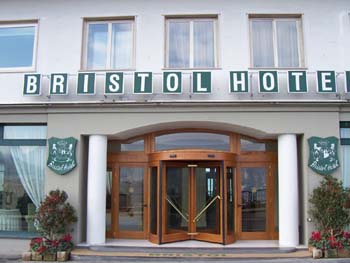
(It should have been – the in season rate for our room was 260 euros a day.) A word about SorrentoAn expensive free dayCapri? non. Positano, si.Early Thursday morning – actually not so early, the gods were kind – we appeared in the lobby to meet our guide who was going to shepherd about Capri. She was a lean and charming Neapolitan who spoke excellent English. Oddly enough, by Italian standards, her English might have been better than her Italian. It seems that accents vary widely in Italy. Standardizing Italian was another of Mussolini’s projects; they’re still working on it. We were not her only wards – there was an Australian couple who would be going to Capri with us. They and we and our guide piled into the van. We drove (actually, were driven) to the dock where our guide conferred with the charter boat that was to take us to Capri. After an extended conversation she came back and gave us the bad news – the sea was too rough. They could get us there but they weren’t sure that they could get us back in the afternoon. Time for plan B. Plan B was to drive along the Amalfi coast to a town called Positano. We were assured Positano were a town well worth visiting, and, of course, the drive along the Amalfi coast would be spectacular. We suppressed our doubts and took her word for it. Besides, we had Luigi. LuigiOur driver was a chap named Luigi. Unfortunately we didn’t think to take a picture of him; he was one of the most colorful characters we met in the entire two weeks. He looked like a character actor in a Dickens’ movie, one of the seedy eccentrics that populate his novels. Luigi had an abundance of gray locks of hair scattered about his large head, a large hook nose, a wide mouth that revealed a paucity of teeth, and a weather beaten sailor’s face that looked like he had seen one too many nor’easters. Deb opined that he looked like a cross between Brutus and Popeye in the Popeye cartoons.While our guide was unsuccessfully negotiating with the boat people Luigi explained town dogs to us. We commented about the number of dogs meandering about the dock that were looking for scraps to eat. Luigi explained that there were two kinds of dogs in Sorrento, dogs that actually belonged to someone and town dogs. According to Luigi people bringing in dogs had to pay a 200 euro registration fee, so many visitors just abandoned their dogs, which then became town dogs. It all sounded plausible at the time, but do you know, I have my doubts.
Traffic stopped several times on the way to Positano. One of these times our guide got out to see what the hold up was this time. While she was out Luigi told us about a bus that had gone off the road at this very point, and that forty people had died in the crash. He was just finishing his story when our guide got back in the van. She scolded him sharply for peddling such stuff and nonsense. The Amalfi CoastPositanoArrivederci Italia.This page was last updated August 1, 2006. |
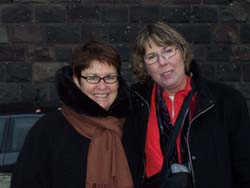 In view of this friendship, it had long been settled that Deborah
should at some point travel to the land of the Romans to visit
her friend of many years and while there visit some of the many
sights that the Italians have maintained throughout the centuries
for the benefit of pilgrims, penitent’s, dissolute sons of
nobility, and tourists. Yours truly quite happily accepted an
offer to be her boon companion in her travels.
In view of this friendship, it had long been settled that Deborah
should at some point travel to the land of the Romans to visit
her friend of many years and while there visit some of the many
sights that the Italians have maintained throughout the centuries
for the benefit of pilgrims, penitent’s, dissolute sons of
nobility, and tourists. Yours truly quite happily accepted an
offer to be her boon companion in her travels.
 Having concluded that life would be better if we departed the day
before our departure, we arrived in time to deposit Bridger at
Minicritters. On his first visit there he was strongly of the
opinion that he DID NOT WANT TO BE THERE. He had a forceful way
of expressing his displeasure. His first tactic was to head for
the door with force sufficient to move a hay wagon full of hay
bales to the south forty. When that didn’t work he sat down with
a “I’m not going anywhere” expression on his face. The staff is
well accustomed to such plays and dealt with his intransigence
by holding a treat in front of his nose. That dog will follow food
anywhere.
Having concluded that life would be better if we departed the day
before our departure, we arrived in time to deposit Bridger at
Minicritters. On his first visit there he was strongly of the
opinion that he DID NOT WANT TO BE THERE. He had a forceful way
of expressing his displeasure. His first tactic was to head for
the door with force sufficient to move a hay wagon full of hay
bales to the south forty. When that didn’t work he sat down with
a “I’m not going anywhere” expression on his face. The staff is
well accustomed to such plays and dealt with his intransigence
by holding a treat in front of his nose. That dog will follow food
anywhere.
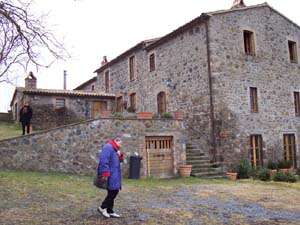 To begin with, we were there in the midst of winter. Night time
temperatures were near 0C (32F) and daytime temperatures were
near 10C (50F). Winter is the rainy season; it rains a lot –
showers rather than hard soaking rains. What this comes to is
that one needs a bit of heat in the winter but one doesn’t need
to be excessively worried about heat and insulation. What this
means is that they can get away with building houses out of field
stone and living in them for five hundred years.
To begin with, we were there in the midst of winter. Night time
temperatures were near 0C (32F) and daytime temperatures were
near 10C (50F). Winter is the rainy season; it rains a lot –
showers rather than hard soaking rains. What this comes to is
that one needs a bit of heat in the winter but one doesn’t need
to be excessively worried about heat and insulation. What this
means is that they can get away with building houses out of field
stone and living in them for five hundred years.
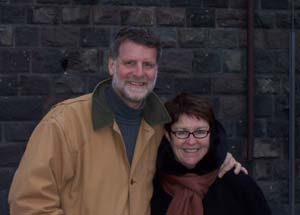 As it happened Jude and Richard were looking for a country place. They
had thought they were going to purchase an abandoned monastery; however
the deal fell through. So instead of buying an abandoned monastery they
bought a nascent guest house from an abandoned wife.
As it happened Jude and Richard were looking for a country place. They
had thought they were going to purchase an abandoned monastery; however
the deal fell through. So instead of buying an abandoned monastery they
bought a nascent guest house from an abandoned wife.
 The objective of the day was to decompress and de-jetlag. Jude and
Richard played host and hostess, and treated us to wonderful food
cooked in real Italian country style. They have their own olive
trees and, if I recall correctly, their own fig trees. There is nothing
special about that – in the Italian countryside everybody has their
own olives and their own figs.
The objective of the day was to decompress and de-jetlag. Jude and
Richard played host and hostess, and treated us to wonderful food
cooked in real Italian country style. They have their own olive
trees and, if I recall correctly, their own fig trees. There is nothing
special about that – in the Italian countryside everybody has their
own olives and their own figs.
 Jude’s mother was also visiting at the same time. She enjoyed visiting,
albeit in poor health. She missed her bridge club and was delighted
to discover that I played Casino – fifteen two, fifteen four, and a pair
is six and all that. I hadn’t played in decades but I still remembered
the rules and the basic strategy. Unfortunately the cards ran all my
way and I skunked her twice running. She must have thought I was some
kind of card sharp.
Jude’s mother was also visiting at the same time. She enjoyed visiting,
albeit in poor health. She missed her bridge club and was delighted
to discover that I played Casino – fifteen two, fifteen four, and a pair
is six and all that. I hadn’t played in decades but I still remembered
the rules and the basic strategy. Unfortunately the cards ran all my
way and I skunked her twice running. She must have thought I was some
kind of card sharp.
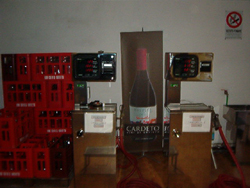
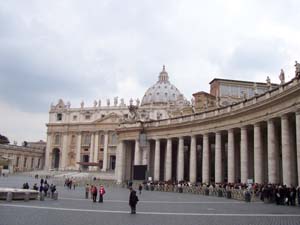 Breakfast completed, we essayed to determine how we might make
our way to the Sistine Chapel, Deborah having a particular desire
to see its fabled wonders. Jude had assured us that it would be
easy to find our way about Rome by buses and had given us a long
list of sights that we simply must see.
Breakfast completed, we essayed to determine how we might make
our way to the Sistine Chapel, Deborah having a particular desire
to see its fabled wonders. Jude had assured us that it would be
easy to find our way about Rome by buses and had given us a long
list of sights that we simply must see.
 It is 320 steps up to the dome which means 320 steps down. There
are signs in Italian and English (but not in Latin to my
disappointment) pointing this out to the weak, the aged, the
infirm, and those with unsound hearts. Since in my opinion
neither of us fell into any of these categories, I blew the
warnings off. Deborah piteously pointed to the elevators.
Taking the elevators would have cost and extra four euros apiece
and would have been to my machismo, so up the stairs we went,
one hundred steps in the first course, one hundred steps in the
second course, one hundred steps in the third course, and twenty
for good measure. We did it at our pace unlike the young persons
who dashed past us at an embarrassing pace. I am firmly of the
opinion that when one is faced with a climb of 320 steps one does
not scamper!
It is 320 steps up to the dome which means 320 steps down. There
are signs in Italian and English (but not in Latin to my
disappointment) pointing this out to the weak, the aged, the
infirm, and those with unsound hearts. Since in my opinion
neither of us fell into any of these categories, I blew the
warnings off. Deborah piteously pointed to the elevators.
Taking the elevators would have cost and extra four euros apiece
and would have been to my machismo, so up the stairs we went,
one hundred steps in the first course, one hundred steps in the
second course, one hundred steps in the third course, and twenty
for good measure. We did it at our pace unlike the young persons
who dashed past us at an embarrassing pace. I am firmly of the
opinion that when one is faced with a climb of 320 steps one does
not scamper!
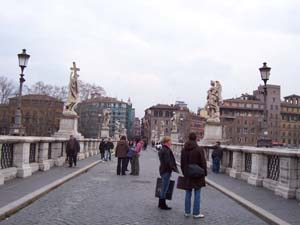 The Basilica is awe inspiring. It is huge, ornate, and uses an
incredible amount of marble; I opine that it represents a
billion dollars worth of marble counter tops. Every square inch
has some form of artwork. It is beautiful and a wonderful
museum, though my calvinist ancestors whispered in my ear, What
does all this wealth and display have to do with Christ?
The Basilica is awe inspiring. It is huge, ornate, and uses an
incredible amount of marble; I opine that it represents a
billion dollars worth of marble counter tops. Every square inch
has some form of artwork. It is beautiful and a wonderful
museum, though my calvinist ancestors whispered in my ear, What
does all this wealth and display have to do with Christ?
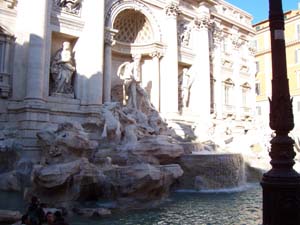
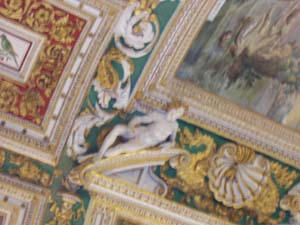 There we were with a whole morning ahead of us. We decided to head off to
the Vatican Museum and take in lots of fabulous art, including the Sistine
Chapel. We hadn’t made any progress in figuring out the best bus route so
we repeating our trek to Piazza Popolo and its convenient taxi. This time
we arrived in time to enter the museum. More precisely we arrived in time
to take our place in line. Apparently a hundred or more people had also
thought it was a good day to visit the museum. The line stretched along
the Vatican wall for about a block or so. However it moved quickly enough
and we got in through the green door well before the 12:20 deadline. I
say green door because the entrance door is a massive green slab
sufficient to stop art thieves driving tanks.
There we were with a whole morning ahead of us. We decided to head off to
the Vatican Museum and take in lots of fabulous art, including the Sistine
Chapel. We hadn’t made any progress in figuring out the best bus route so
we repeating our trek to Piazza Popolo and its convenient taxi. This time
we arrived in time to enter the museum. More precisely we arrived in time
to take our place in line. Apparently a hundred or more people had also
thought it was a good day to visit the museum. The line stretched along
the Vatican wall for about a block or so. However it moved quickly enough
and we got in through the green door well before the 12:20 deadline. I
say green door because the entrance door is a massive green slab
sufficient to stop art thieves driving tanks.
 In the fullness of time we arrived at the Sistine Chapel. It had been
recently restored and was utterly magnificent. I suppose every one has
seen a copy of the painting showing God reaching out to Adam. What one
doesn’t realize is that it is just one of about thirty paintings on the
ceiling.
In the fullness of time we arrived at the Sistine Chapel. It had been
recently restored and was utterly magnificent. I suppose every one has
seen a copy of the painting showing God reaching out to Adam. What one
doesn’t realize is that it is just one of about thirty paintings on the
ceiling. 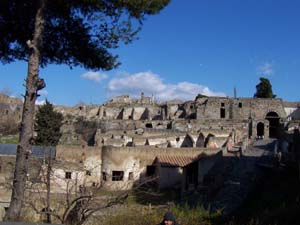 Oops. The science lecture isn’t quite done. When people are buried in ash their soft
parts eventually rot out leaving their skeletons in a body shaped hole in the ash. The
archaeologist chappies drilled holes into the ash surrounding the body shaped hole and
filled it with plaster. When the plaster set they removed the surrounding ash to get
plaster body casts with skeletons inside of them. Clever, eh what? So much for the
science lecture.
Oops. The science lecture isn’t quite done. When people are buried in ash their soft
parts eventually rot out leaving their skeletons in a body shaped hole in the ash. The
archaeologist chappies drilled holes into the ash surrounding the body shaped hole and
filled it with plaster. When the plaster set they removed the surrounding ash to get
plaster body casts with skeletons inside of them. Clever, eh what? So much for the
science lecture.
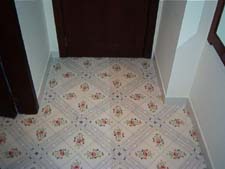 There we learned the truth – all our fears were groundless; the
hotel staff knew all about us. The Bristol hotel was wonderful!
It is on a height, built right into the cliff face. Our room,
and indeed all of the rooms, faced the bay with a view of
Sorrento, the port, and the lights of Napoli in the distance. We
had a balcony with a view, though we didn’t make real use of it –
the evenings were a bit chilly. The floor of the room was
porcelain tile with blue scroll work and red roses – this was
Italia, after all. The dining room, called the peacock room, had
elaborate patterned tiles featuring peacocks. The food
(breakfast and the evening meal were part of the package) was
excellent. In short it was just the place to relax for a day, do
nothing in particular, and be pampered.
There we learned the truth – all our fears were groundless; the
hotel staff knew all about us. The Bristol hotel was wonderful!
It is on a height, built right into the cliff face. Our room,
and indeed all of the rooms, faced the bay with a view of
Sorrento, the port, and the lights of Napoli in the distance. We
had a balcony with a view, though we didn’t make real use of it –
the evenings were a bit chilly. The floor of the room was
porcelain tile with blue scroll work and red roses – this was
Italia, after all. The dining room, called the peacock room, had
elaborate patterned tiles featuring peacocks. The food
(breakfast and the evening meal were part of the package) was
excellent. In short it was just the place to relax for a day, do
nothing in particular, and be pampered.
 Every where we went Luigi was talking to someone. At one point he stopped
in the middle of the street and shouted at a man across the street. After
a bit of voluble Italian the man came over and handed Luigi some money.
Evidently Luigi was a man of many enterprises. It is probably best not
to inquire too closely into what they might have been.
Every where we went Luigi was talking to someone. At one point he stopped
in the middle of the street and shouted at a man across the street. After
a bit of voluble Italian the man came over and handed Luigi some money.
Evidently Luigi was a man of many enterprises. It is probably best not
to inquire too closely into what they might have been.